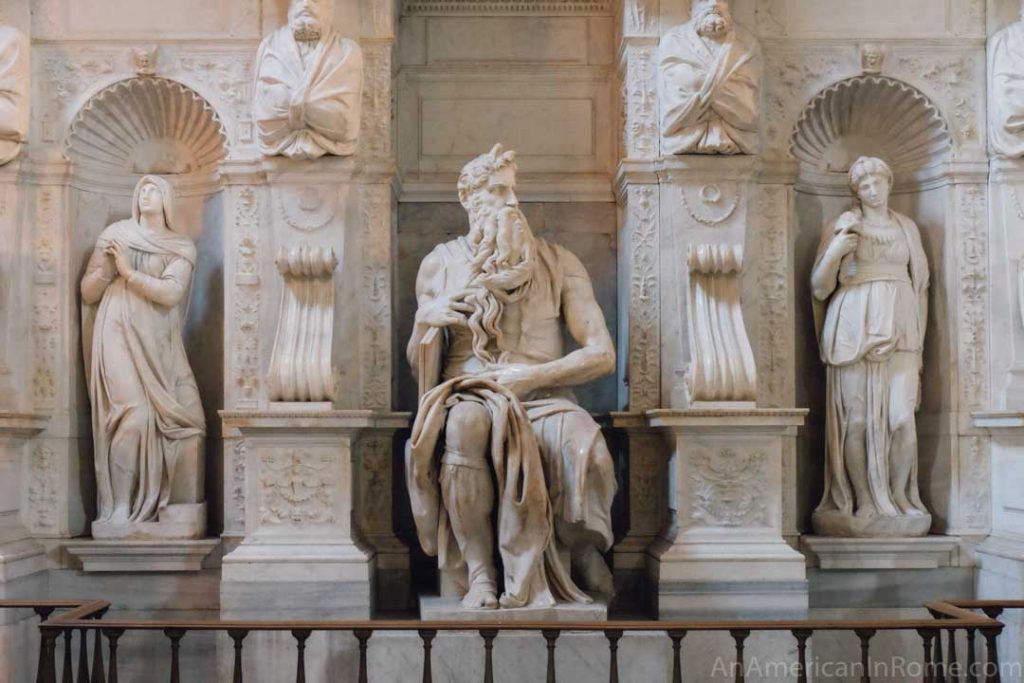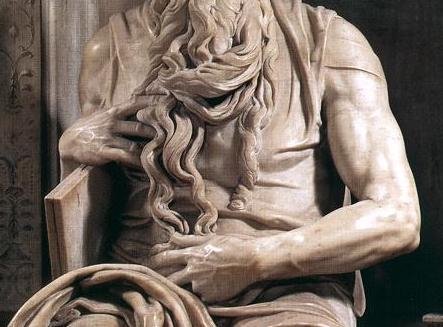Moses is a sculpture by the Italian High Renaissance artist Michelangelo Buonarroti, housed in the church of San Pietro in Vincoli in Rome. Commissioned in 1505 by Pope Julius II for his tomb, it depicts the biblical figure Moses with horns on his head, based on a description in chapter 34 of Exodus in the Vulgate, the Latin translation of the Bible used at that time.

Pope Julius II commissioned Michelangelo to build his tomb in 1505 and it was finally completed in 1545; Julius II died in 1513. The initial design by Michelangelo was massive and called for over 40 statues. The statue of Moses would have been placed on a tier about 3.74 meters high (12 ft 3 in), opposite a figure of St. Paul. In the final design, the statue of Moses sits in the center of the bottom tier.

Giorgio Vasari in the Life of Michelangelo wrote: "Michelangelo finished the Moses in marble, a statue of five braccia, unequaled by any modern or ancient work. Seated in a serious attitude, he rests with one arm on the tables, and with the other holds his long glossy beard, the hairs, so difficult to render in sculpture, being so soft and downy that it seems as if the iron chisel must have become a brush. The beautiful face, like that of a saint and mighty prince, seems as one regards it to need the veil to cover it, so splendid and shining does it appear, and so well has the artist presented in the marble the divinity with which God had endowed that holy countenance. The draperies fall in graceful folds, the muscles of the arms and bones of the hands are of such beauty and perfection, as are the legs and knees, the feet were adorned with excellent shoes, that Moses may now be called the friend of God more than ever, since God has permitted his body to be prepared for the resurrection before the others by the hand of Michelangelo. The Jews still go every Saturday in troops to visit and adore it as a divine, not a human thing."

The English translation of Freud's "The Moses of Michelangelo" also provides a basic description of the sculpture: "The Moses of Michelangelo is represented as seated; his body faces forward, his head with its mighty beard looks to the left, his right foot rests on the ground, and his left leg is raised so that only the toes touch the ground. His right arm links the Tables of the Law with a portion of his beard; his left arm lies in his lap."
The depiction of a horned Moses stems from the description of Moses' face as "cornuta" ("horned") in the Latin Vulgate translation of the passage found at Exodus chapter 34, specifically verses 29, 30 and 35, in which Moses returns to the people after receiving the commandments for the second time.

Although Jerome completed the Vulgate in the late 4th century, the first known applications of the literal language of the Vulgate in art are found in an English illustrated book written in the vernacular, that was created around 1050: the Aelfric Paraphrase of the Pentateuch and Joshua. For the next 150 years or so, evidence for further images of a horned Moses is sparse. Afterward, such images proliferated and can be found, for example, in the stained glass windows at the Chartres Cathedral, Sainte-Chapelle, and Notre Dame, even as Moses continued to be depicted many times without horns. In the 16th century, the prevalence of depictions of a horned Moses steeply diminished.

In Christian art of the Middle Ages, Moses is depicted wearing horns and without them; sometimes in glory, as a prophet and precursor of Jesus, but also in negative contexts, especially about Pauline contrasts between faith and law - the iconography was not black and white. The depiction with horns is first found in 11th-century England. Melinkoff (1970) speculated that while the horns of Moses in origin were in no way associated with those of the Devil, the horns may nevertheless have developed a negative connotation with the development of anti-Jewish sentiment in the early modern period.